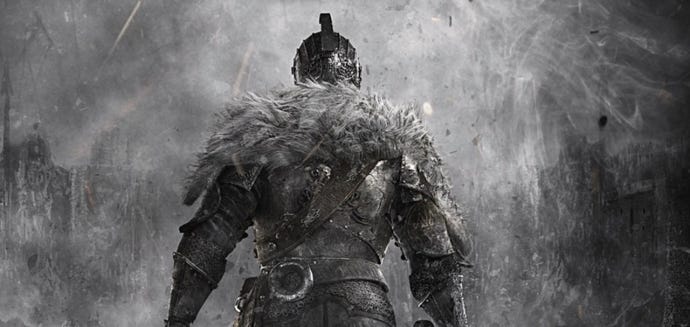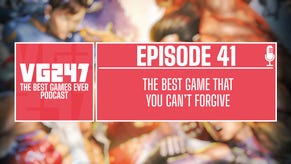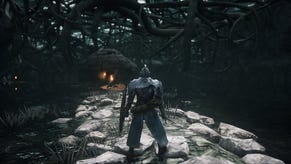Dark Souls 2 – delving into the dark soul of From Software
Stace Harman speaks to Namco Bandai producer and Dark Souls 2 spokesperson, Tak Miyazoe, about the frustration levels, streamlining and role-playing of From Software’s deadly sequel.
"Dark Souls 2 hasn’t suddenly become about good and evil, there’s just more opportunity to pick a side, if you want to."
Most games begin in a deliberately sedate manner. There’s usually a tutorial section that takes place in a walled-off and mostly safe environment where you can learn the nuances of control, get to grips with game mechanics and work out which end of the pointy-stick is used for poking the bad guys. After that, you are typically shepherded out into the world, pointed in the right direction and then stopped every few minutes so that the developers can highlight some new trick or to drop the mind-bending revelation that fire weapons are useful against ice demons.
From Software’s Souls series isn’t like most games. Following the lead of its predecessors, Dark Souls 2 provides some basic exposition to establish the context of your actions and then cuts you loose. Here, you’ll attempt to find your own way, experiment with various elements and encounter the flora and fauna of its world, much of which will try to kill you.
For many players, this is all part of the thrill of the Souls series and, in an admittedly twisted manner, part of its charm – a game that treats you like an adult with a brain, rather than like a child who has never picked-up a controller. However, there have been elements of the Souls series that have perhaps taken this a step too far; ideas that have been a little too sparsely explained, such as the world tendency in Demon’s Souls and then the extent to which covenants could affect your game in Dark Souls.
These are elements where the basic germ of an idea is understood but the way in which it can restrict your options or be manipulated for a more comprehensive experience can go largely unknown without the aid of a guide or internet chatter.
“We're definitely aiming to reduce some of the frustration of not knowing and of being confused because things aren't clear,” acknowledges Namco producer and From Software liaison, Tak Miyazoe.
“There'll always be things that aren't fully explained because that's part of From's design ethos and it's important to maintain that sense of realisation when you figure something out for yourself, but we want to minimise those elements that make you feel like something is so obscure it’s pointless, because if you get to that stage then you’re really just a step away from stopping caring about it.
“There were some elements like that in Dark Souls and while Dark Souls 2 won't explain everything to you - in fact it will hardly explain anything to you - it's about being able to offer that faint light of hope that makes you want to find more information about something and then giving you the tools to do so. Maintaining that mystery is an important part of Dark Souls 2 but it's just about streamlining that process a little bit and reinforcing player choice.”
One area set to benefit from this reinforcement is the notion of role-playing and how that ties to your choice of character class, covenant affiliation and your interaction with other players. Going back recently to the original Dark Souls, I was struck by how far I’d moved away from the class that I’d chosen at the outset of the game and how, one hundred hours later, my initial choice of thief had basically boiled down to having a particularly high dexterity stat. While it’s great for my thief to be afforded the freedom to be standing adorned with Ornstein’s armour, an Iaito+15 and the Sunlight Shield, it occurred to me that she hadn’t done a whole lot of thieving and I felt that that I could have ended up at this point regardless of my starting class.
“So, the classes are a little bit more defined this time around,” Miyazoe confirms. “As you highlight, in Dark Souls you could pick a class and turn it into something different and while we haven’t restricted players from playing the way they want to, there is some better definition.
“For example, the dual-wielding class has its own motions, animations and play style, so I don’t think anyone would really pick a dual-wielder and play it as a sorcerer. We want to emphasize the role-playing in the game a little bit more, not just in the classes but also in the covenants, which will also promote role-playing a little more.”
This will be good news to those who found the whole notion of covenants impenetrable and, consequently, expendable. Or who flitted between them for the immediate benefit that membership might convey in the short-term or while inhabiting a particular area. Miyazoe has previously touched on some of the examples of the changes to the covenant system but is keen to highlight that as well as being easier to understand, they’ll also play a bigger role in the game.
In the first instance, this will be achieved by having a number of the covenants promote a specific way of playing. So, while the Way of the Blue is geared towards promoting a play-through in which players don’t invade others and whose members will automatically receive aid from their covenant brethren if they themselves are invaded, The Brotherhood of Blood is the obvious choice for those looking to cause mayhem in other players’ worlds.
“I think in Dark Souls you could read about the covenants online and the descriptions in-game but still not get a full grasp for what the covenants actually did,” says Miyazoe. “An element of that mystery is still there but in Dark Souls 2 we want people to take part in a certain covenant because it means something to them.
“There’s a stronger focus on good and evil with covenants like the Way of the Blue and Brotherhood of Blood, but alongside these you also have roles such as Bell Keepers, who aren’t necessarily good or bad but have a certain role in the world.
“Dark Souls 2 hasn’t suddenly become about good and evil, there’s just more opportunity to pick a side, if you want to, and it’s about facilitating a greater degree of meaningful player choice.”
One of the key choices to be made by any Dark Souls players is whether or not they are going to play the role of invader. Personally, it’s something that I tried a couple of times but derived no real pleasure from, preferring instead to work collaboratively in multiplayer against the fearsome bosses or to fight off invaders that strayed into my world. However, in Dark Souls 2 From Software is attempting to leverage its popular invasion mechanic and implement a degree of parity by having PvP matches take place in specific locations.
A similar thing was attempted with the Artorias of the Abyss DLC for the original Dark Souls, which had an arena mode for dedicated PvP in addition to the standard invasion method with the former ultimately proving unpopular and limited in scope. I think that part of the thrill of invasions comes from playing cat and mouse in a familiar but labyrinthine area, like The Duke’s Archives, or having to negotiate the threat of a player invasion in addition to fighting off the standard enemies and it would be disappointing if this were to be lost in favour of straight-up duelling.
While there’s not too much information on that front at the moment, there are some additional details on how the matchmaking for these PvP encounters will take place. Having taken on board the feedback of the system in Dark Souls and examined how people were using it – and, in some cases, manipulating it – From has made various tweaks to the system.
"Spoilers are the biggest enemy of our game and we believe that spoilers are the biggest enemies of the fans too."
Some of these have to do with the option for regional or worldwide matchmaking while others revolve around the ability to burn certain items at bonfires that affect different parameters, such as increasing the cooling-off time between potential invasions. At its most basic level, the formula used to determine matchmaking has also been amended, as Miyazoe explains.
“The formula for invasion has been complicated further because we found that really experienced players would maintain a low-level character in order to invade with high success rates. In order to try and avoid that we have taken into consideration more parameters such as game-play hours, number of souls and other factors.
“This makes the formula more complicated on the invasion side but on the collaborative side the [Name-engraved] ring will offer you a greater chance of teaming-up with a friend, or at least trying to, which will hopefully increase the fun factor.”
“Fun-factor” is perhaps not a phrase that one would usually associate with the Souls series but it’s not without precedent. The infamous pendant incident was a prime example of Dark Souls’ director Hidetaka Miyazaki’s sense of humour and while Miyazaki may only be on-board here in an advisory role I spied an item during my hands-on time that suggests his mischievous sense of humour may yet live on in the sequel.
One of the starting items available to my explorer class was the “Petrified Something”, which is described as “A simple petrified lump. It may be of use, someday”. So, could this be the item that proves that From Software is not beyond trolling its fans all over again or one that will kick-off an all together more rewarding treasure hunt? When I put this to Miyazoe the producer pauses and then laughs.
“The problem is that spoilers are the biggest enemy of our game and we believe that spoilers are the biggest enemies of the fans too,” Miyazoe begins with a grin. “So, there's a part of me that wants to run through examples of what's in the game and how they affect play but then there's a part of me that knows that as much as people might want to hear about it, they'll also hate me for telling them!”
It’s true, for as much as I want to know, I also don’t want to be robbed of the privilege of discovery or indeed risk spoiling it for others. Instead, I must wait for the release of Dark Souls 2 next month, when we’ll all be able to start to unravel its mysteries to gain a better understanding of the implications of the changes that have been made, for better or for worse. Perhaps then we’ll also find out just what that “petrified something” actually does; maybe some things are better left a mystery.
Dark Souls 2 will be available on PS3 and 360 from March 11 in the US, March 14 in Australia and Europe. A PC release will follow after.














